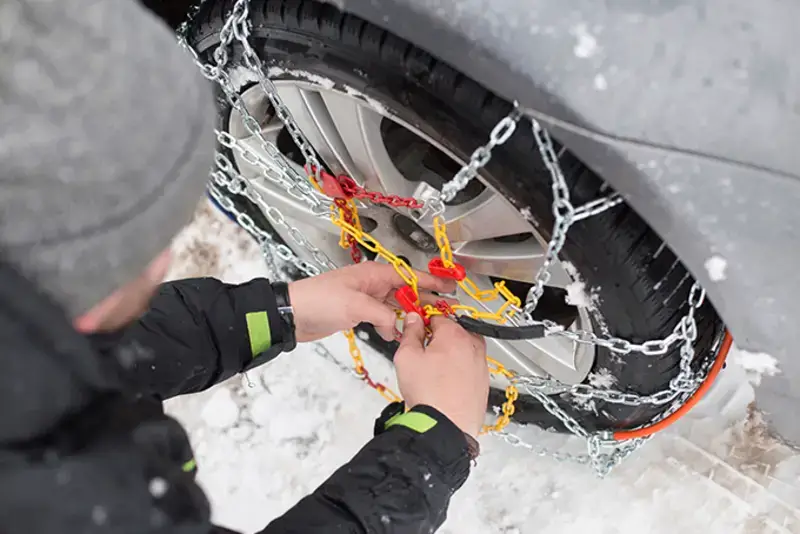Comparing Different Types of Snow Chains for Tyres

Snow Chains for Tyres
As winter approaches and the roads become coated in ice and snow, drivers across the globe prepare for the challenges that come with navigating through wintry conditions. One essential tool in a driver’s arsenal for safe winter driving is snow chains for tires. Snow chains provide additional traction and grip on slippery surfaces, allowing vehicles to maintain control and stability.
However, with various types of snow chains available on the market, it can be challenging to determine which ones are best suited for your vehicle and driving needs. In this blog post, we’ll compare different types of snow chains for tires to help you make an informed decision.
1. Traditional Link Chains
Traditional link chains are the most basic and commonly used type of snow chains. They consist of metal links that form a mesh around the tire tread, providing traction on snow and ice. These chains are typically affordable and widely available, making them a popular choice for many drivers.
However, traditional link chains can be noisy and may cause vibration while driving, especially at higher speeds. Additionally, they require manual installation, which can be cumbersome and time-consuming, especially in harsh weather conditions.
2. Diamond Pattern Chains
Diamond pattern chains are designed with a series of metal plates arranged in a diamond-shaped pattern across the tire tread. This design helps to provide better traction and grip on icy surfaces while minimizing noise and vibration.
Diamond pattern chains are often easier to install compared to traditional link chains, thanks to their innovative design. They also tend to offer smoother driving performance and improved handling, making them a preferred choice for drivers who prioritize comfort and convenience.
3. Cable Chains
Cable chains, also known as wire chains, are made of steel cables wrapped around the tire tread. These chains are lightweight, compact, and easy to install, making them a popular choice for drivers who want a hassle-free solution for navigating through snowy conditions.
Cable chains are also less prone to causing damage to vehicles with limited clearance, such as those with minimal wheel well space. However, they may not provide as much traction as traditional link or diamond pattern chains, particularly in deep snow or severe ice conditions.
4. Composite Chains
Composite chains are a modern alternative to traditional metal chains, made from a combination of metal and composite materials. These chains offer the durability and strength of metal chains while being lighter and quieter to drive on.
Composite chains are also less likely to damage the road surface compared to metal chains, making them a preferred choice for environmentally conscious drivers. However, composite chains may come at a higher price point compared to other types of snow chains, and they may not be as widely available.
5. Automatic Tensioning Chains
Automatic tensioning chains feature a built-in tensioning system that automatically tightens the chains as you drive, eliminating the need for manual adjustments. These chains are designed for maximum convenience and ease of use, allowing drivers to install them quickly and securely without the hassle of stopping to tighten them manually.
Automatic tensioning chains are ideal for drivers who frequently encounter varying road conditions or who want a set-it-and-forget-it solution for winter driving. However, they may come at a higher price point compared to traditional chains.
6. Sock-Style Chains
Sock-style chains, also known as fabric chains or textile chains, are made of high-strength fabric materials that wrap around the tire tread like a sock. These chains are lightweight, compact, and easy to install, making them a popular choice for drivers who want a portable and versatile solution for winter driving.
Sock-style chains are also less likely to cause damage to vehicles or road surfaces than traditional metal chains. However, they may not provide as much traction as metal chains, especially in severe winter conditions.
Conclusion
When it comes to selecting the right snow chains for tires, there are several factors to consider, including driving conditions, vehicle clearance, and personal preferences. Traditional link chains offer reliable traction at an affordable price but may be noisy and difficult to install.
Diamond pattern chains provide improved traction and handling with reduced noise and vibration, while cable chains offer a lightweight and compact alternative for hassle-free installation.
Composite chains combine the durability of metal chains with the lightweight and quiet performance of composite materials, while automatic tensioning chains and sock-style chains offer maximum convenience and versatility for drivers.
Ultimately, the best snow chains for tires will depend on your specific driving needs and priorities. Whether you prioritize traction, convenience, or environmental impact, there is a snow chain option available to suit your requirements. Be sure to carefully research and compare different types of snow chains before making a purchase to ensure you select the right ones for safe and confident winter driving.
Read Also










